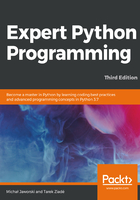
Modern Python Development Environments
A deep understanding of the programming language of choice is the most important thing in being an expert. This will always be true for any technology. Still, it is really hard to develop good software without knowing the common tools and practices that are common within the given language community. Python has no single feature that cannot be found in some other language. So, in direct comparison of syntax, expressiveness, or performance, there will always be a solution that is better in one or more fields. But, the area in which Python really stands out from the crowd is the whole ecosystem built around the language. The Python community spent years polishing standard practices and libraries that help to create more reliable software in a shorter time.
The most obvious and important part of the ecosystem is a huge collection of free and open source packages that solve a multitude of problems. Writing new software is always an expensive and time-consuming process. Being able to reuse the existing code instead of reinventing the wheel greatly reduces development times and costs. For some companies, it is the only reason why their projects are economically feasible.
Because of this, Python developers put a lot of effort into creating tools and standards to work with open source packages that have been created by others—starting from virtual isolated environments, improved interactive shells, and debuggers, to programs that help to discover, search, and analyze the huge collection of packages that are available on Python Package Index (PyPI).
In this chapter, we will cover the following topics:
- Installing additional Python packages using pip
- Isolating the runtime environment
- Python's venv
- System-level environment isolation
- Popular productivity tools